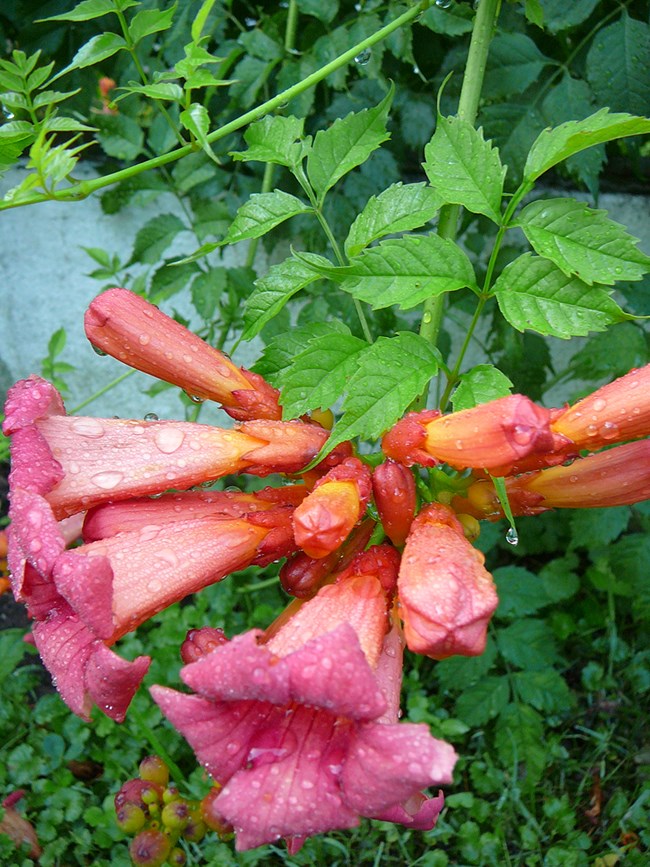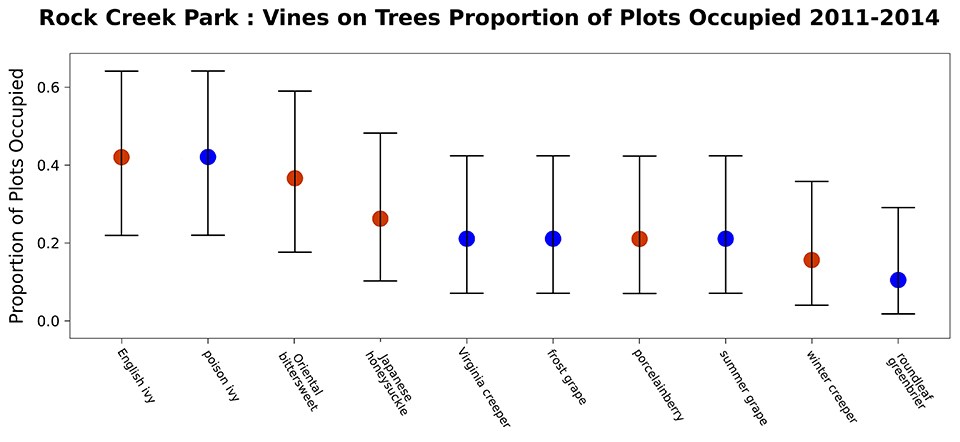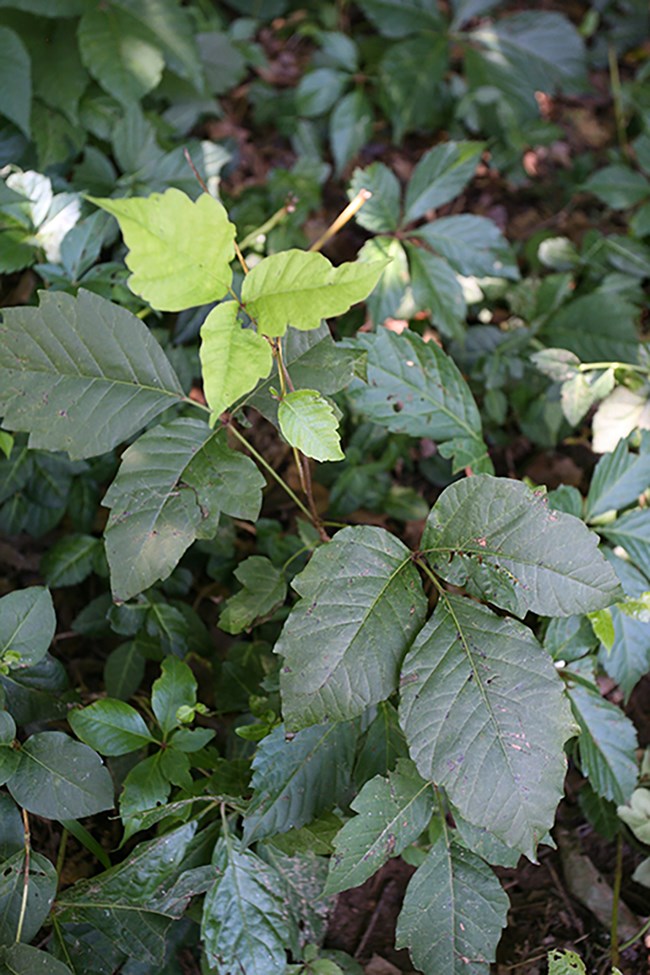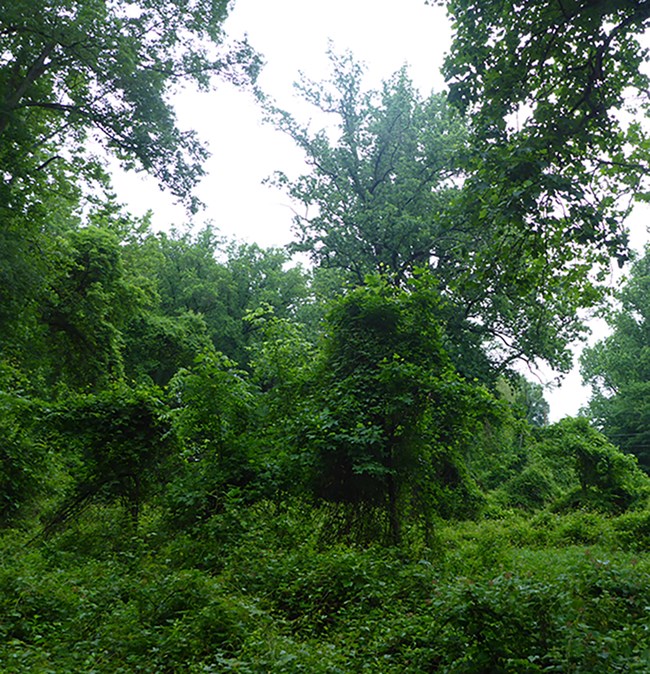Last updated: September 21, 2020
Article
Rock Creek Park Vines
Native vines are an important part of the Rock Creek Park forests, but they sometimes get tangled up in the fight against non-native invasive plants. Here’s why we should even “embrace” poison ivy, while being wary of the sweet-smelling Japanese honeysuckle vine.
Vines in Rock Creek Park

NPS/Nortrup
To protect this treasure, National Park Service staff from the Inventory and Monitoring (I&M) program monitors forests in Rock Creek Park, tracking the growth of park vegetation including trees and vines.
Monitoring takes place at nineteen plots in Rock Creek where every tree is inspected for the presence of vines and the species of each vine is recorded. This brief presents the most recent data on vines found in I&M forest plots in Rock Creek.
What's a Non-Native Invasive Vine?
A vine is a weak-stemmed plant that requires other plants or structures to support itself and grow upward.Non-native plants are plants introduced from other regions or habitats. They’re sometimes called weeds, exotics, or invasives. Non-native invasives can disrupt naturally-balanced plant and animal communities by growing aggressively, adapting quickly to new habitats, and multiplying. Wildlife that is dependent on native plants is often unable to adapt and is forced to migrate to the ever shrinking suitable habitat that remains.
Rock Creek's Top 10 Vines

Vines & Wildlife
Vines provide an important food resource for birds, deer, and native moth species. Some vines, such as the native frost grape (Vitis vulpina), can be one of the only food sources for resident birds during the cold winter months. Vines can also offer nesting material for birds from their shredded bark and they provide shelter for many mammals.Embracing Poison Ivy!?!

NPS/Nortrup
Twining and Clinging
Many non-native, invasive vines such as Oriental bittersweet (Celastrus orbiculatus) and Japanese honeysuckle (Lonicera japonica) are known to strangle and kill trees. They do so by twining tightly around parts of the tree, cutting through the bark, and blocking the tree’s internal flow of water and nutrients. This twining trait is generally more common for non-native, invasive species and can stunt tree growth, as well as increase tree mortality.Other methods of climbing are less destructive. Native vines like Virginia creeper (Parthenocissus quinquefolia) will climb high into the tree canopy by adhesively clinging to the bark. Native grape vines will climb trees using tendrils that grasp onto branches and other supporting objects. Unlike strangling, twining vines, grapes will hang loosely from the trees and normally do not choke their host tree.
Effects of Vines

NPS/Nortrup
All vines have the potential to spread out and cover branches, blocking needed sunlight and eventually killing a tree. An infested tree can show signs of decline for several years before it dies. Although the death of a tree can allow for more sunlight to reach the forest floor, that sunlight can fuel both native vine species and harmful non-native, invasives. Non-native invasives have successfully exploited these opportunities and are increasing at a faster rate than their native competitors.
As vines grow higher onto tree branches and stems, their sheer weight is capable of snapping large limbs. The loss of these branches means a loss of leaves and reduces the ability of the tree to gain energy from the sun. Resulting tree death can lead to a less biodiverse forest and an unhealthy mature tree canopy. Additionally, large falling branches can pose a safety and financial hazard for the park and its visitors.
Help Lend a Hand
We welcome you to join us as a volunteer to help control these non-native, invasive vines. You can join Rock Creek Park staff or one of the park’s partner groups (e.g. Dumbarton Oaks Park Conservancy or Rock Creek Conservancy) to assist on removals. But remember, removing vines in Rock Creek without authorization is illegal and poor methods or mis-identification of species can cause great harm.
You can browse a helpful, photo-rich identification key to vines in Rock Creek Park. To learn more about NCRN forest monitoring, visit the NCRN website.
